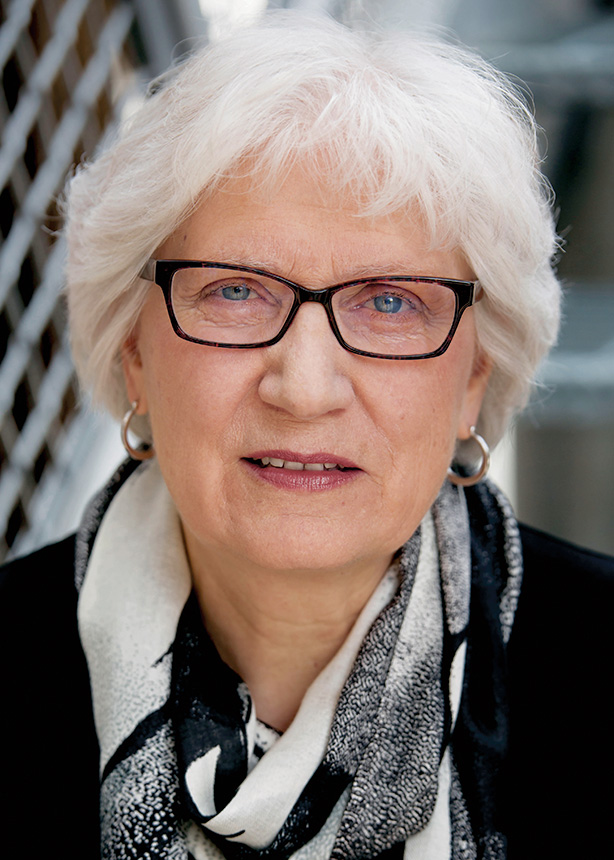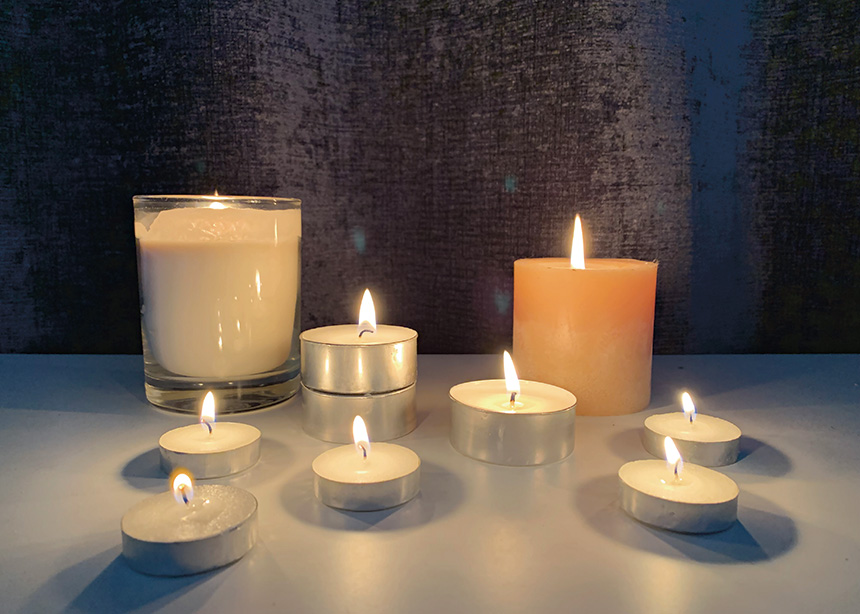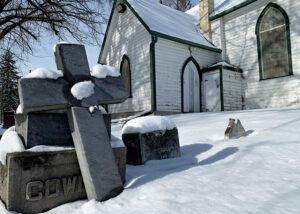 There were nineteen beds in the hospice, that’s what I heard, most of them occupied, but I paid no attention to them. When we first arrived, yes, I’d glanced into the room next to his and saw a tiny woman in the bed, tucked up like a newborn, and the next morning the bed was freshly made and empty. There was a stained-glass butterfly lamp beside the book where we signed in every day because of the Covid, and they put the little memorial cards—like place cards—with the latest names in front of it. There was always one new card, it seemed, sometimes two. But it was true what a character in Brit Bennett’s The Vanishing Half says about death: “Only the specifics of it hurt. Death, in a general sense, was background noise.”
There were nineteen beds in the hospice, that’s what I heard, most of them occupied, but I paid no attention to them. When we first arrived, yes, I’d glanced into the room next to his and saw a tiny woman in the bed, tucked up like a newborn, and the next morning the bed was freshly made and empty. There was a stained-glass butterfly lamp beside the book where we signed in every day because of the Covid, and they put the little memorial cards—like place cards—with the latest names in front of it. There was always one new card, it seemed, sometimes two. But it was true what a character in Brit Bennett’s The Vanishing Half says about death: “Only the specifics of it hurt. Death, in a general sense, was background noise.”
He was the one who mattered, he was the specifics that hurt.
Strictly speaking, he’d been palliative since the time of his diagnosis some two-and-a-half years earlier, of prostate cancer metastasized to his bones. Meaning there was no ultimate cure. But quality of life, some quantity too, was possible, given current advances in cancer mitigation.
The things people said to us about our situation were often doleful, as if they imagined us perpetually sad, but we slept and ate and talked and did our household chores and connected with our children and grandchildren—carefully or virtually during the pandemic—and we read and watched movies or the news. He tended his balcony plants and a garden plot at the apartment complex and kept the bird feeders stocked. He continued to volunteer at Habitat for Humanity and a local thrift shop. Eventually his mobility lessened and independent walking turned into walking with a cane, to walking with a walker, to needing a wheelchair. But the balance between living and dying was weighted on the side of living.
Until it shifted, that is, and to my mind tipped heavily to dying, the mid-October day his pain was so excruciating he couldn’t rise from his bed and in the wake of that had to be hospitalized to get it under control. And then we were told that options for “treatment” had finally run out and from now on, back home, it would be strictly management of his pain.
“Well,” he said to me, in the wry uncomplaining way he had, “they’re not going to bark up a tree where there’s no cat.”
But even then. Even then, back home with his family doctor and palliative team in charge instead of the oncologist, and hydromorphone doses steadily increasing to confront his suffering, he lived. The seed catalogue in the mail excited him. He loved our Christmas drive to view the lights. He kept doing what he could.
I asked, more than once, “Are you scared?”
And he always said “No.”
On one occasion I remarked it didn’t seem fair; at sixty-nine, he was too young for this. His eyes filled with tears, as they did so easily those months, and we hugged. He said I smelled good.
“Well,” I said, pressing in for another embrace, “smell me again.”
But the diminishments of function continued. “His body’s breaking down,” our son told me bluntly, gently, when I phoned him in distress about his father’s latest bodily humiliation. “Reverting.” “I know, I know,” I said. The scale had tipped—drastically—toward death. Now I tried to remember our conversations. I tried to remember and record his sentences because all of them seemed last words.
It was an up and down, inhabiting that fraught space of waiting and uncertainty. A rollercoaster, we called it. We knew we were observers in the midst of his dying, but no one could predict for us how long it might take.
We were governed by rules at the hospice because of the pandemic: only two in the room and the same two all day and no overnight, unless the circumstances were exceptional—meaning, unless he was very close to the end. Of his sixteen days in residence, I attended for fourteen; the children took turns accompanying me. I yielded two days to children-in-law so they could spend a day with him as well.
On one of the days I wasn’t at the hospice, he asked a nurse to connect us by phone. “Life is upside down,” he began. He’d had a bad night. He felt the staff were upset with him, because he’d tried to get out of bed.
“Are you having pain?”
“Not at the moment, but it can come as fast as saying Johnny Appleseed.”
Then he said, “I’ll have to get out of here.”
“You mean out of the hospice?”
“No,” he said. “You know I won’t be getting out of that.”
Oh. I’d skimmed Final Gifts by Maggie Callanan: about listening to “nearing death awareness.” About listening for what the dying may be trying to communicate. About the message behind the words.
Oh. I told him I wanted to be there but today it was the girls who were coming. I told him I put seeds into the birdfeeder. I told him a hummingbird had stopped by for a drink. I said a prayer and he said thanks and we said goodbye and ended the call, and I thought about his attempted escape and I wailed a little.
I returned home exhausted at the end of each day I spent at the hospice. I was on the tail end of months of being support and carer—done gladly, I’m truly relieved to say in retrospect—and because it had been intense and intimate, I didn’t want it to be over yet. But I wanted to be done with it too. For his sake—he’d suffered much—and for mine.
He sent me off with a “go in peace” one evening, and I had supper and settled into a Netflix movie. When the credits rolled, I felt a jarring sensation, for during the entire time of the movie I’d forgotten my dying husband a forty-minute drive away, and it felt something like guilt, but sorrow piled on to it too because now I remembered him and how we used to enjoy going to movies—we preferred the big screen—and we would never do that again, and besides that, the smallest and worst thing of all, his toothbrush was still in the cup in the bathroom and though he would never need it, I couldn’t bear to throw it out. And every time I brushed my teeth I saw it and I wanted to back up and beg for a re-do. Not of the suffering, not of the pain, not that, but even to have him well enough to look at his phone and tell me the weather for the day, to make the breakfast porridge, to shuffle behind his walker. I couldn’t keep up with this event, I couldn’t process it. And besides being at the hospice, the children and I were making cremation arrangements—the hospice office needed to have them decided—and composing his obituary, planning an online service, setting up a memorial site. And my role as chief information officer—so many messages coming in, so many people wondering how he and we were doing—was in overdrive. (“Note to self,” I wrote in my journal, “don’t ask questions of those in this situation. Questions want to be answered. Just say, ‘thinking of you and no need to reply.’”)
Most nights I slept well and woke re-energized and eager to get to the only place I wanted to be. At the hospice. In his room. Beside his bed. When I wasn’t there, I prayed, and tried to trust he wasn’t alone.
“Do you feel God’s presence?” I asked.
“Has he ever left?” he said.
There was no fuzzy spiritual radiance in the room; that would be entirely the wrong impression to convey, for those days were far more difficult and mundane than that, but we’d been married forty-six-plus years and he’d been a father for forty-four and the children and I were drawn to him and his approaching death and it held us like a grip, and in spite of our sadness, I think, we sensed the mystery, the strange tenderness of it all, and some kind of glory too was leaking out of his transition away from us. I brought my sketchbook along one day and sketched him sleeping on a page where I’d earlier put down some watercolour as background. Later I realized that, unplanned, his face had landed in a patch of warm yellow, as if bathed by light.
Later, I read Kathryn Mannix’s wonderful book With the End in Mind: Dying, Death, and Wisdom in an Age of Denial. I’d heard her first on the CBC program, “White Coat, Black Art” with Dr. Brian Goldman, explaining the process of dying, how people get more tired, need to sleep more, how their sleeps get longer and longer, how they may slip into unconsciousness, how their breathing changes, becomes “an automatic reflex cycle.” How slow breathing may alternate with regular and steady breathing. How the noisy breathing of the last days doesn’t hurt. How it eventually slows and stops. How death is “usually okay”—that is, painless and peaceful.
I could put everything we experienced into the patterns Mannix describes in her book. At least three, maybe four, times we found ourselves holding his hands and speaking or singing or not speaking, but sure it was the end, his breathing slow, lengthy pauses between. And then, as if picking up steam, carrying on again. In the last four or five days he didn’t eat or drink, except for that gulp of water. Mostly he slept, breathing in, breathing out. Breathing out, and in.
Later our daughter showed me a short video she’d taken of him in hospice. The ticking of the clock in the room was loud and obvious on the video. “Ticking away the time,” she remarked. But when I’d been in the room, I never heard the clock. The only sound I really heard was his breath. How it grew louder and raspier, how it played with the phlegm building in his throat, how it slowed and seemed to stop. How it continued.
That’s how it had been the last Saturday morning too, us thinking “the end,” but no, not yet. The day passed. We got supper and ate it beside him in the room.
Should we stay? The nurse on duty couldn’t advise us either way. “He’s still breathing from his diaphragm,” she ventured. So, we might surmise he would last the night. On the two days previous, our sons—not sure their turn in the rotation would come up again—had said their private goodbyes. Now our daughter did the same. We left.
I went to bed early. I had just sunk deeply into sleep when the phone jangled me awake. It was someone from the hospice on the line. My husband had died.
Peacefully, said the nurse who witnessed it.
Peacefully, of course. The last breath is an exhale.
This phenomenon—dying when family have left—is also a pattern, Mannix writes. It occurs “with such regularity that we often warn families, especially when the dying process stretches over several days, that it may happen.” Is it the presence of people they love that keeps dying persons hanging on? Are they choosing? “We don’t know the answers,” she says, “but we recognize the pattern.”
One of our sons and I drove through the dark—a great kindness, it seemed, that dark—back to the hospice. Back to the familiar room, now utterly quiet. Entering it, I was pierced by the quiet, by the surely impossible absence of the sound of him breathing.
We connected virtually with the other children and together participated in a small ceremony of washing and dressing the body. I’d forgotten a comb so his soft silver hair got fluffed. We had a psalm and a prayer. When we were done, I stayed a while alone in that impossible stillness and heard myself keening, as if I’d tuned into some ancient and continuous high-strung note, desolate as smoke. But then I had to leave his body behind, just as he’d left it behind.
At the far end of the hallway, by the sign-in book and the glowing butterfly lamp, stood a new “in memory of” card. The name on it was his.
The personal essays in Dora Dueck’s Return Stroke—from which the above is excerpted and adapted—engage with a range of ideas, including motherhood, the ethics of biography, a child’s coming-out and the role of imagination within religious faith. Dora Dueck is the author of four books of fiction, All That Belongs (2019), What You Get At Home (2013), This Hidden Thing (2010), and Under the Still Standing Sun (1989). She lives in B.C.
Related articles:
Holy moments in the midst of grief
Hold tenderly to death









Leave a Reply
You must be logged in to post a comment.